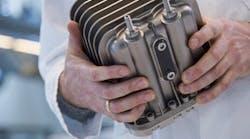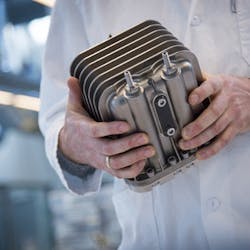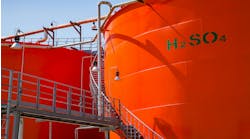Small-Scale Onsite CO Production Takes Big Step
Gas Innovations, La Porte, Texas, is pioneering innovative technology from Haldor Topsoe, Lyngby, Denmark, for small-scale onsite production of carbon monoxide. The technology offers a safe, efficient and cost-competitive option for companies that require smaller quantities of CO.
The specialty chemical, plastic, pharmaceutical, metallurgical, electronic and medical industries all require CO in their production processes. Most small-scale users (10–300 Nm3/h) have lacked a real alternative to buying CO in large gas cylinders, typically tube trailers that are parked next to the unit consuming the gas until the cylinders are empty. Getting CO this way not only is expensive but also involves a safety risk from transporting, handling and storing large amounts of CO, which is classified as a poison. So, companies have had to rely on inefficient workarounds to avoid the safety and logistics issues posed by using CO. Haldor Topsoe’s onsite CO production unit — eCOs — eliminates these risks. Switching to an eCOs system offers improved efficiency, throughput and economy.
A Breakthrough Technology
The current landscape of CO production for packaging into cylinders and tube trailers is quite consolidated with only four locations in North America where CO is loaded into tube trailers for redistribution. The flexibility of the eCOs unit promises to disrupt the current supply chain; to answer the historic supply issues associated with CO, hydrocarbon and specialty gas supplier Gas Innovations started up the world’s first eCOs unit early last year.
[callToAction ]
The eCOs production of CO differs significantly from the traditional supply by steam methane reformation (SMR) units. SMR plants typically are very large, require a substantial capital expenditure (capex), and demand much maintenance and associated downtime. In contrast, an eCOs unit needs minimal capital, much less maintenance and downtime, and takes up a relatively small footprint. Being able to generate CO when needed from a plant that is very easy to operate and with minimal capital investment was what made the difference for Gas Innovations.
Purity levels from the eCOs unit exceed those of isotopic production, the traditional source of the highest purities of CO for industries such as electronics and one that entails long lead-times and large minimum volume purchases. Product gas from the eCOs unit contains no O2 or H2O — CO2 is the primary contaminant.
Figure 1. Solid oxide electrolysis cell efficiently converts electricity and CO2 into CO and O2.
From a Gas Innovations perspective, onsite production of CO using the eCOs unit brings many benefits to the market. These extend well beyond adding another supplier and include reduced safety risks (obviously the number one benefit) as well as decreased handling and transportation. The predominant feedstock, CO2, is inert and easily inventoried onsite, then processed as required for storage as inventory CO or refilled into cylinders.
Operators at Gas Innovations and engineers at Topsoe communicate via the Internet — engineers in Denmark monitor the eCOs unit and can contact the operators via their smart phones. The electronic communication, remote diagnosis and simultaneous view of the system have demonstrated great value.
Second Unit On Its Way
Gas Innovations began operating its first eCOs unit in January 2016 and has been running the plant continuously since then. The daily production of CO has been very stable; the unit’s outstanding flexibility allows the company to scale the production and choose the necessary purity for its needs at any given time.
Based on that unit’s successful operation, Gas Innovations recently signed a contract for a second eCOs unit with ten times larger capacity. The new unit will be able to produce 96 Nm3/h (3,650 SCF/h) CO at up to 99.999-vol% purity and should be online at the end of 2017.
Gas Innovations has entered into a 15-year pay-per-use agreement with Haldor Topsoe; this includes remote assistance and monitoring, replacement of electrolysis parts, and operator training. With a low capex business model, Gas Innovations can spend its capital focusing on core business issues.
The collaboration between Gas Innovations and Haldor Topsoe will develop the CO market for many industries, with onsite production, backup supply during shutdown and maintenance periods, as well as bulk gas delivery. While technology is the foundation of Haldor Topsoe, Gas Innovations prides itself on its technology relationships and works to bring these respective technologies to market. The eCOs production initiative is a prime example of such a technology relationship.
The future will include another mode of supply for CO, an additional purity level and related supply efficiencies. As an independent wholesale supplier to the industrial gas industry, Gas Innovations will make Topsoe’s technology available to the entire industry. Whether in the Americas or in the most remote locations of the world, Gas Innovations will deliver the full range of packages to meet industries’ requirements. Onsite CO production even may suit larger volume applications where CO2 and electricity are available.
The Production Unit
Available in ranges from 6 Nm3/h to 200 Nm3/h, eCOs units may be installed in parallel for larger applications. The unit’s small footprint and modular design allow for fast and compact onsite installation. Additional space is required for CO2 supply; however, inventory storage is minimal compared to tube trailer supply.
The eCOs unit comes as a stand-alone package with power, CO2 and product gas connections. Companies with little or no previous experience in operating chemical plants can safely operate the unit.
The name eCOs stands for “electrolytic carbon monoxide solution.” Haldor Topsoe’s vast experience with fuel cells and separation technology underpins the development of eCOs.
The heart of an eCOs plant is the solid oxide electrolysis cell (Figure 1). It can convert electricity and CO2 into CO and O2 with high efficiency and at high reaction rates. The cell operates at relatively high temperatures (700–850°C) that make the reaction possible.
The unit produces CO with greater than 99.95% purity, which satisfies the requirements of almost all CO applications. For a 99.96%-purity CO produced with eCOs, most of the contamination consists of CO2 (330 ppm) and N2 (30 ppm). The levels of O2, CH4 and H2O typically fall below 0.1 ppm and H2 is under 2 ppm. The ultralow amounts of O2 and hydrocarbons make CO from eCOs superior to traditional reformer-based CO for many specialty and high purity applications.
Fostering Sustainability
The physical characteristics of CO, particularly its poison classification, make risk management a top priority. An eCOs unit minimizes the amount of CO kept on site; instead, the primary product stored is the inert CO2 feedstock for the process. When CO2 is electrolyzed to CO, the byproduct is harmless O2 that either may be used locally or released to the environment without problems.
In the longer run, this technology can underpin a whole new segment of green and sustainable chemicals from renewable carbon sources. Combining the eCOs technology with electricity from a sustainable source and a non-fossil-based supply of CO2 can produce 100% renewable negative-carbon-footprint syngas. The possibilities for 100% renewable, negative-carbon-footprint chemicals are wide and include other chemical precursors, fuel and plastics. Even without fossil fuels, the world still will depend upon carbon chemistry and eCOs will be part of the solution.
ASHLEY MADRAY is executive vice president of Gas Innovations, La Porte, Texas. CASPER HADSBJERG is business director at Haldor Topsoe, Lyngby, Denmark. Email them at [email protected] and [email protected].



